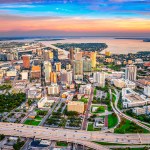Inflation has reached its highest level since the early 1980s, when the economy was in the throes of a double-dip recession. Are we doomed to repeat the same result?
Not necessarily. Worries about inflation are typically couched in terms of whether it will spiral out of control and prompt the Federal Reserve to act to reduce growth that leads to a recession. That happened in the 1970s and early 1980s, but there are important differences between the economy of that era and today that are likely to mitigate the likelihood of “stagflation.”
In any event, high inflation might not be a big problem for commercial real estate. A recent study by Greg MacKinnon, research director of the Pension Real Estate Association, found that commercial real estate performance has been good during periods of high inflation and that returns are much more closely correlated to growth than inflation.
“The lesson for today’s real estate investors trying to interpret what the macroeconomic environment means for real estate is that overall economic strength is much more important than whether inflation may rise or fall going forward,” the paper said. Or as MacKinnon put it in a recent webinar: “If the economy is doing well, real estate will do well, no matter what happens with inflation. Inflation is not critical in itself for commercial real estate.”
GDP, Inflation Highest in Decades
U.S. GDP is projected to top 5.0% for the year, the first time it would reach that level since 1984, when it was 7.2%. Inflation growth reached 6.8% year-over-year in November, the fastest rate since January 1982, and has been above 5% for the last six months.
The spikes in growth and inflation have been caused by a culmination of events started by the pandemic, the unprecedented halt to parts of the economy and the extraordinary amount of monetary and fiscal stimulus provided by the federal government. While few expect inflation to recede to the Fed’s target level soon, the prognosis and severity are debated. Optimists say that inflation will gradually ease.
Others say inflation may not be so quick to recede. One reason is the rapid growth in housing costs—reflected in the 13.7% growth in U.S. multifamily asking rents year-over-year through November, according to Yardi Matrix—which comprise nearly one-third of the CPI.
Federal Reserve chairman Jerome Powell and other Biden administration officials downplayed the potential of long-term inflation for most of the year, dubbing it “transitory.” However, more recently they stopped using that word, and they are now talking about unwinding the Fed’s $9 trillion balance sheet. While Federal Reserve executives are not commenting on raising the fed funds rate, most observers expect rates to increase starting in 2022 (earlier than previously expected).
Are ‘70s Comparisons Overblown?
Since there is consensus that inflation will remain above trend through 2023 or later, the debate is centered around how bad that is for the economy and whether it sets off a spiral of negative events.
Inflation has been very low for a long time, so a short period of running hot isn’t likely to do any permanent damage. But rising wages and materials costs could prompt companies to raise prices to maintain profits, and if consumers feel pressure and lose confidence, they could stop spending.
If inflation does spiral, it could prompt the Federal Reserve to raise rates sharply and throw the economy into a recession, which happened during the last period of sustained inflation in the 1970s and 1980s. There are good reasons to think that the 1970s comparisons are overblown. For one thing, price hikes today remain well below levels in the 1970s and ‘80s, when inflation reached as high as 14.8% in 1980.
Another dissimilarity is that the economy has generally been strong for years, with interest rates and unemployment steadily declining over the past decade (other than the pandemic). The 1970s inflation had multiple drivers, but the main one was the sharp spike in oil and gas prices. Domestic oil production has grown dramatically, and the U.S. is not at the mercy of foreign producers as it was in the 1970s. What’s more, the U.S. economy is more diverse and resilient than it was in the period leading up to stagflation.
Is CRE a Hedge Against Inflation?
Commercial real estate is commonly believed to serve as a hedge against inflation, because rents and values tend to rise in an inflationary environment. To test the theory about inflation, the PREA study looked at total returns of properties in the NCREIF Property Index, which comprises core properties owned by institutional managers. The study calculated returns between 1978 and 2020 through periods of low, medium and high GDP and inflation growth. The study found that returns were the highest in periods of high growth and low inflation, but that growth was a much more relevant factor to performance than inflation.
The evidence seems to indicate that high inflation over time is a lesser problem for commercial real estate than low growth. Even so, it is appropriate that policymakers adjust policy sooner rather than later to prevent negative impact to consumer and business confidence. And the real estate industry should not be sanguine about the potential for havoc that inflation could create and should instead plan accordingly.
Read the full analysis: Inflation Fears and Commercial Real Estate











Add Comment